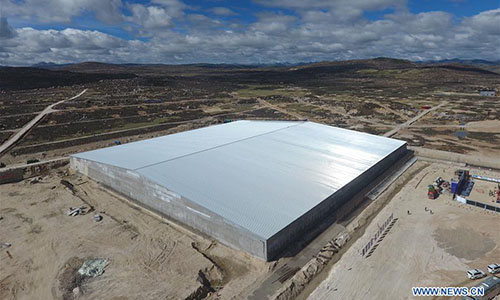
Aerial photo taken on June 19, 2018 shows the Water Cherenkov Detector in the Large High Altitude Air Shower Observatory (LHAASO) which is under construction in Daocheng County, southwest China's Sichuan Province. An observatory for detecting cosmic rays is being built in Sichuan Province. The project, known as the LHAASO, is located in mountains of the eastern part of Qinghai-Tibet Plateau at an average altitude of 4,410 meters. (Xinhua/Liu Kun)
A cosmic ray observatory in Southwest China's Sichuan Province has found the highest energy photons within the observable range of human beings, and the findings may help unravel the "mystery of the century" regarding the origin of cosmic rays, scientists said on Monday.
The observatory has recorded the highest energy photon of 1.4 Peta electron volts (PeV). This is the highest energy level ever observed, changing people's traditional understanding of the Milky Way.
A large number of ultra-high energy cosmic accelerators have also been discovered in the Milky Way by the cosmic ray observatory, and an era of "ultra-high energy gamma astronomy" has started, according to a joint press conference held by the Institute of High Energy Physics (IHEP) under the Chinese Academy of Sciences (CAS) and Springer Nature on Monday, according to The Paper.
In 2019, human beings detected the first celestial body with ultra-high energy gamma-ray radiation. Unexpectedly, the number of "ultra-high energy" gamma ray sources has increased to 12, based on LHAASO's observation data, said Cao Zhen, chief scientist at LHAASO and a researcher at the IHEP.
These discoveries started the era of ultra-high energy gamma astronomy, indicating that non-thermal radiating objects represented by the Cygnus star-forming region and the Crab Nebula - that is, young massive star clusters, supernova remnants and pulsar wind clouds - are the best candidates for the origin of high-energy cosmic rays, helping to solve the "mystery of the century" of the origin of cosmic rays.
Ultra-high energy gamma astronomy, in which the energy exceeds 10 to the power of 14 electronic volts, is the last and the highest energy electromagnetic radiation window in the universe observed by human beings so far.
The detection of ultra-high energy gamma rays has always been a great challenge, as the amount of the rays is very small and they are submerged in the huge cosmic ray background, according to an explanation from the CAS on the Guancha news website.
The Large High-Altitude Air Shower Observatory (LHAASO), is located in the mountains of the eastern Qinghai-Tibet Plateau at an altitude of 4,410 meters, and is a major part of the national scientific and technological infrastructure to observe and study cosmic rays.
The project was launched in 2017 and is expected to be fully completed by 2021. The observatory began its scientific observation in April 2019.
Global Times
